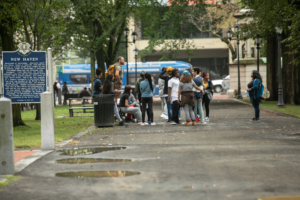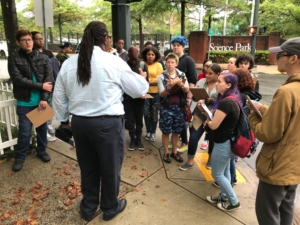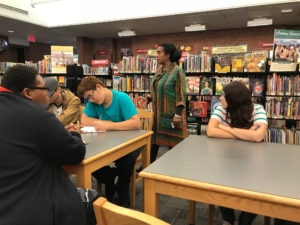by Joel Tolman, Director of Impact & Engagement
The school year has just started, but Common Ground 10th grader Anthony Mitchell has already left the classroom behind.
On the very first day of class, Anthony and his classmates met up with Kevin Ewing and Nikki Katz of Baobab Tree Studios for a workshop on storytelling — the first of six sessions they’ll spend together this semester.

Anthony and his classmates explore the New Haven Green with local historian Colin Caplan. Photo credit: Chris Randall.
A week later, all 60 Common Ground sophomores were down on the New Haven Green for a photo scavenger hunt with local photographer Chris Randall, a tour of downtown with historian Colin Caplan, and a descent into the crypt under Center Church with Michele Reynard. One of the meeting rooms at New Haven City Hall became their meetup point for lunch and an end of day debrief.
Just yesterday, Anthony and his fellow 10th graders headed out into the city once more. They learned about change and gentrification in Newhallville from Stacy Spell, who grew up in that neighborhood and now leads gang intervention programs in the city. From there, they headed to Fair Haven, where neighborhood activist Lee Cruz led them on a whirlwind tour of American history, including one of the nation’s few monuments to African American soldiers, an EPA air quality monitoring station, a section of the nation’s strategic oil reserve, the historic fishing grounds of the Quinnipiac people, and present-day efforts in urban agriculture and alternative energy. They also headed over to Dixwell, where library branch manager Diane Brown opened their eyes to the deeply rooted African American community in that neighborhood. Erik Clemons and Opal Harmon at ConnCAT offered up their beautiful space as a meet-up location
Anthony said he particularly appreciated being pushed by Diane Brown to explore black history in New Haven — and also appreciates the focus on New Haven that organizes the entire class. “It’s been really good to go out into the community — to talk not just about Common Ground, but about New Haven as a whole. We’ve talked with people who want to share their knowledge. I appreciate that our teachers are thinking about their students when they create these classes, listen to our voices. You’re just writing for no reason, learning grammar and stuff. There’s a real purpose.”
Dayanara Chacon, one of Anthony’s classmates, agrees that local learning is more real — and feels like personal discovery, as well as academic learning. “Personally, I like to know where I am. My family is protective of me, so high school was where I started to explore my community. In the core, our teachers really want us to personalize the experience. It’s really structured and planned, which is important. But they don’t tell us what to think. The person next to me may live in the same neighborhood, but may have had a really different experience, so their stories will be really different.”
Blurring the lines between classes & subjects
Dayanara explained another way in which this new classroom experience is breaking down the traditional classroom walls: integrating subjects that are normally separate to tackle common questions and challenges. “In English, Ms. Champagne is really getting us to explore our neighborhoods and tell their stories. In science, we’re making maps with Ms. Brostrom. Ms Williams, who teaches history, is really helping me build the skills I need for other classes — which is the whole point of having an integrated core. Ms. Powell’s interdisciplinary methods class gives me a chance to get to know other students better, and keep practicing those skills. ”
Across all these classes, students are working on the same big projects and performances. In the first unit of the course — which runs through the start of November — all this work will come together into a web site that shares students’ growing understanding of their city. Later in the school year, students will produce interactive theater pieces that explore justice and change in the city, create art and issue briefs that address climate change, and create public service announcements and research briefs aimed at creating a healthier community.

Stacy Spell, retired homicide detective and Newhallville native, talks about Yale’s growth into this historically African American neighborhood.
Some students are still getting used to these community-based experiences and interdisciplinary learning opportunities. Out on Dixwell Plaza, Imani Harrison explains, “It’s all new — the interdisciplinary methods part is a surprise, because we’ve never done anything like that before.”
What are students actually learning?
In fact, this isn’t the first time that Common Ground’s Class of 2020 has broken new ground. Last year, they were the first class to experience our integrated 9th grade core — combining math, science, social studies, and English to take on a series of quarter-long units off study. While their 10th grade curriculum focuses on New Haven as its primary learning lab, their 9th grade experience got them grounded in Common Ground’s 20-acre site. They gathered and published family food stories and cooked with food from our farm; built community and academic skills by taking on survival challenges in the woods of West Rock; used poetry, scientific facts, the historical record, and mathematical reasoning to combat implicit bias and explore their own identities; and debated how to improve their school.
Does blurring the classroom walls actually help students learn, or just sound good on paper? The 10th grade core is just starting up, so the strongest evidence we have at the moment is the feedback of students like Anthony, Dayanara, and Imani. But the 9th grade core is now going into its second iteration, so has generated a year’s worth of data and experience.
There’s good news to share:
- If the goal was to provide more experiences that connected students to their places and communities, we succeeded! The percentage of 9th graders who have learning experiences focused on their local community and environment — including field trips, projects, research, and reflection — increased substantially from 2016-17 to 2017-18. For instance, the percent of students who say they “always” or “frequently” take on projects focused on their community or local environment increased from 22% in 2016-17 to 52% in 2017-18. The percent who say they always, frequently, or sometimes take on field work focused on the local community and environment increase from 41% to 81%.
- In 9th grade, the class of 2020 made greater gains in math than 99% of their peers nationally — growing at 3.4 times the rate predicted, according to results of the NWEA Measures of Academic Progress. In language usage, their growth put them in the 90th percentile.
- Nine in 10 of last year’s 9th graders earned enough credit to move to the 9th grade, up from 87% the year before. This is a particularly big deal given that these students were challenged with 8 total classes — four in the core curriculum, plus four other classes, including a second math class, while previous 9th grade classes only took 5 classes each semester.
- In a survey at the end of the year, we asked these 9th graders about how experiences at Common Ground had impacted them beyond academics. The percentage of students who agreed or strongly that, “because of experiences at Common Ground, I am a leader” was 50% — up from 32% in the previous 9th grade class. The percentage of 9th graders who said experiences at Common Ground had caused them to be someone who cares about the environment was 57% — up from 46% the year before. Students were also more likely to call themselves change agents, and care about social justice issues, than the previous class of 9th graders.
At the same time, the 9th grade core teachers have also made some big changes in response to students’ experiences last year. Students’ big gains in math and language usage weren’t matched in reading, where students’ growth rates put them in the 67th percentile nationally — so the teaching team is intentionally integrating more reading strategies and aligning skills development work across classes. And they also want students to be able to spend more time exploring connections across subjects and doing real work — so cut the number of big units that students will experience from four to three.
Back in the 10th grade core, Anthony also has ideas for improvements. He’d like to be able to take an AP course alongside the English he’s learning in the core, and sees pros and cons of some other features of the experience. “Because you’re with the same people all four parts of the core, it gives you a chance to bond — but there’s also a downside, because I’d like to be able to spend time with other students too.”
But he is clear about the value of all the big team of community-based and classroom teachers he’s experiencing, and it’s clear that he understands what ties this core experience together. “We’ve gotten a lot of people coming in, getting outside perspectives. They’re all teaching us how to tell the story of New Haven.”






Leave A Comment